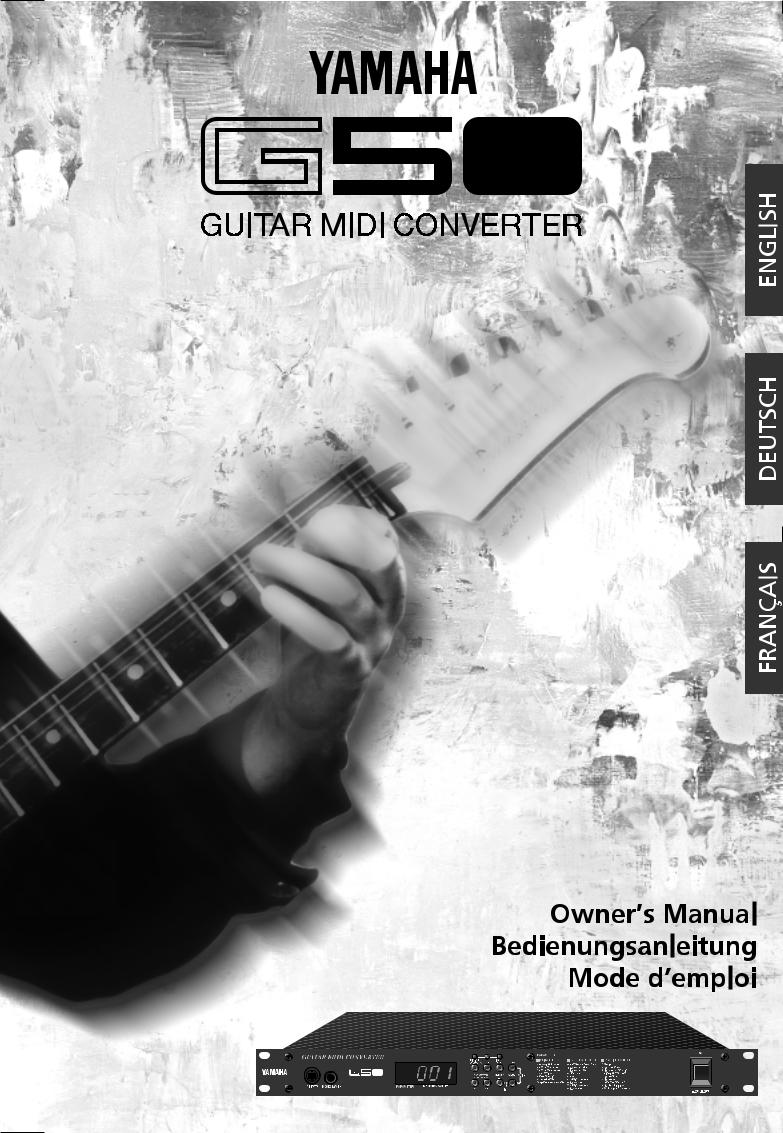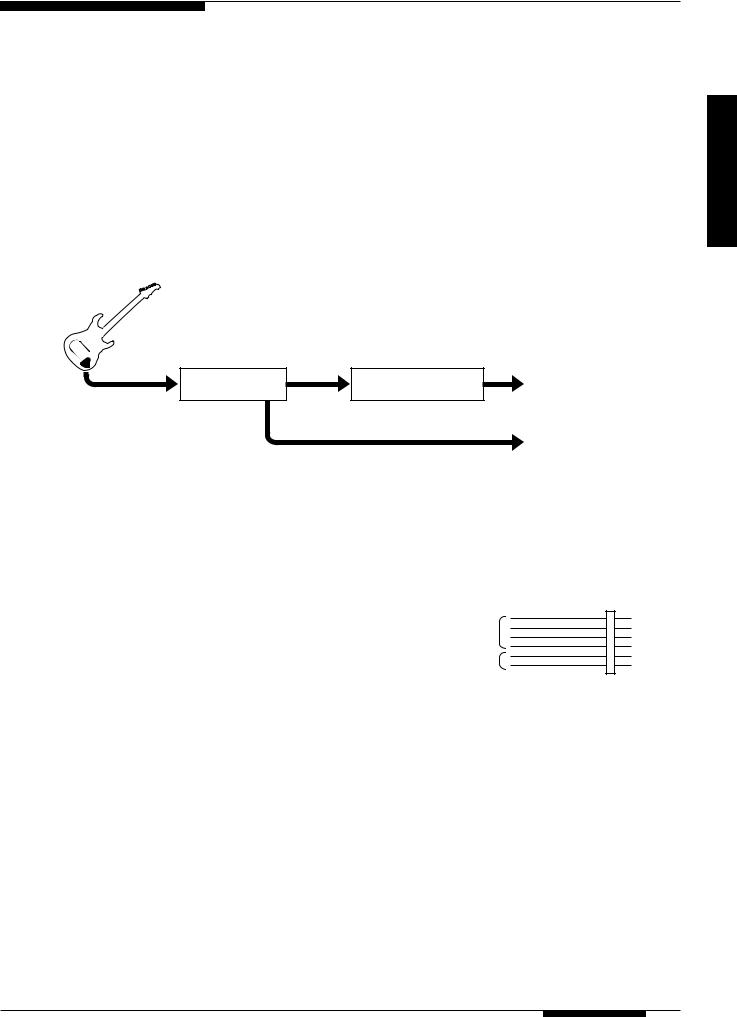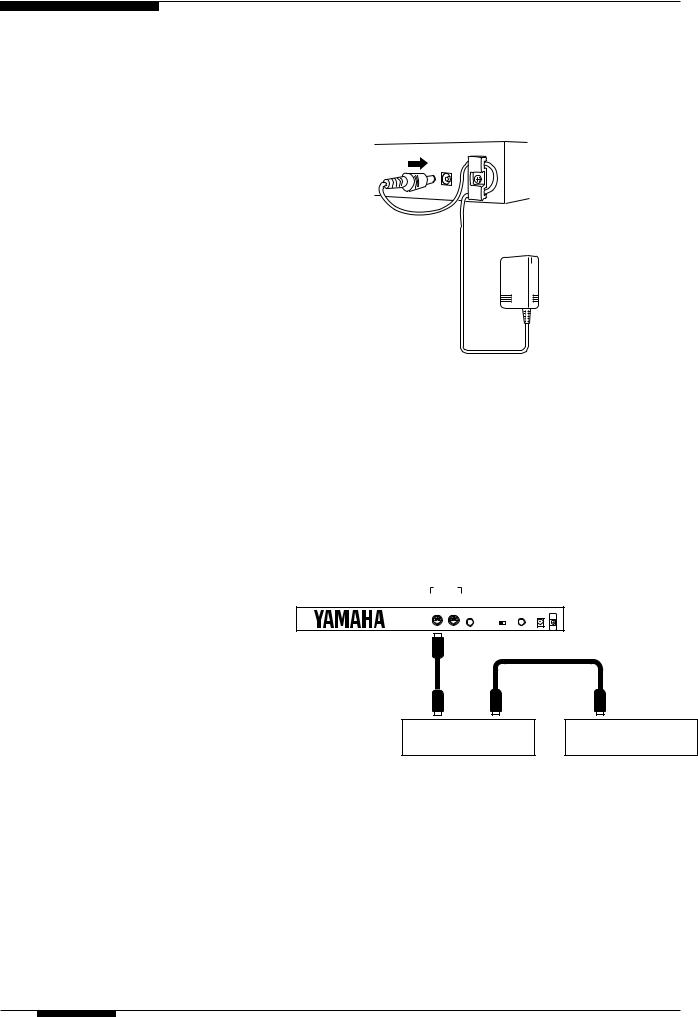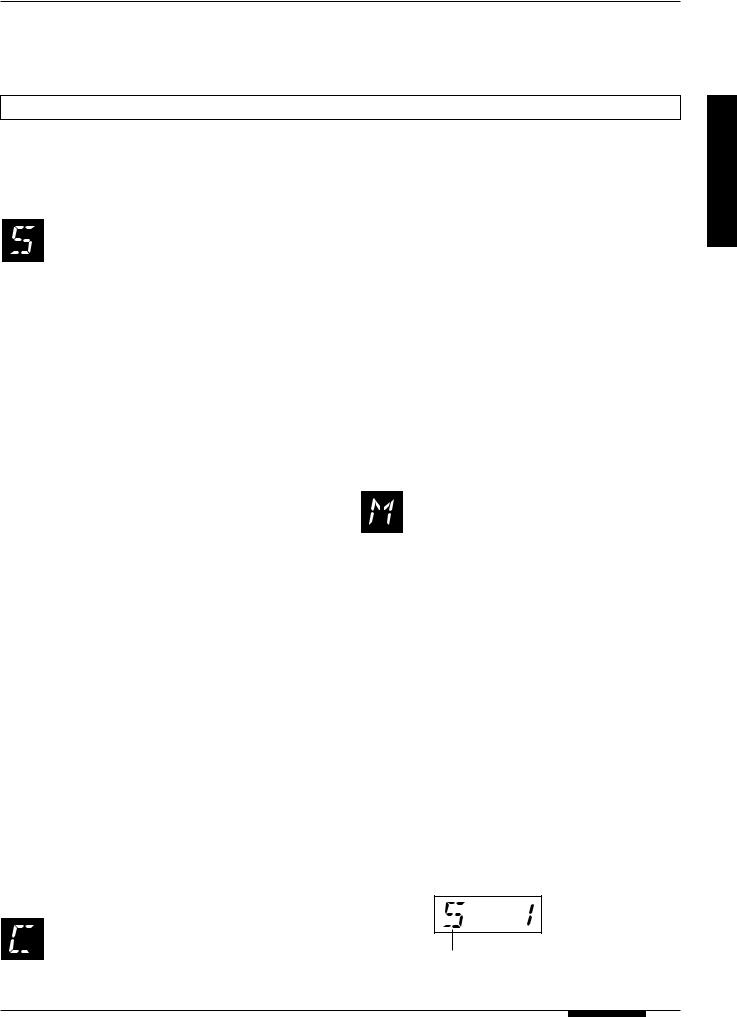Yamaha G50 User Manual


FCC INFORMATION (U.S.A.)
1.IMPORTANT NOTICE: DO NOT MODIFY THIS UNIT!
This product, when installed as indicated in the instructions contained in this manual, meets FCC requirements. Modifications not expressly approved by Yamaha may void your authority, granted by the FCC, to use the product.
2.IMPORTANT: When connecting this product to accessories and/or another product use only high quality shielded cables. Cable/s supplied with this product MUST be used. Follow all installation instructions. Failure to follow instructions could void your FCC authorization to use this product in the USA.
3.NOTE: This product has been tested and found to comply with the requirements listed in FCC Regulations, Part 15 for Class “B” digital devices. Compliance with these requirements provides a reasonable level of assurance that your use of this product in a residential environment will not result in harmful interference with other electronic devices. This equipment generates/ uses radio frequencies and, if not installed and used according to the instructions found in the users manual, may cause interference harmful to the operation of other electronic devices. Compliance with FCC
regulations does not guarantee that interference will not occur in all installations. If this product is found to be the source of interference, which can be determined by turning the unit “OFF” and “ON”, please try to eliminate the problem by using one of the following measures:
Relocate either this product or the device that is being affected by the interference.
Utilize power outlets that are on different branch (circuit breaker or fuse) circuits or install AC line filter/s.
In the case of radio or TV interference, relocate/ reorient the antenna. If the antenna lead-in is 300 ohm ribbon lead, change the lead-in to co-axial type cable.
If these corrective measures do not produce satisfactory results, please contact the local retailer authorized to distribute this type of product. If you can not locate the appropriate retailer, please contact Yamaha Corporation of America, Electronic Service Division, 6600 Orangethorpe Ave, Buena Park, CA90620
The above statements apply ONLY to those products distributed by Yamaha Corporation of America or its subsidiaries.
* This applies only to products distributed by YAMAHA CORPORATION OF AMERICA.
NEDERLAND / NETHERLAND
•Dit apparaat bevat een lithium batterij voor geheugen back-up.
•This apparatus contains a lithium battery for memory back-up.
•Raadpleeg uw leverancier over de verwijdering van de batterij op het moment dat u het apparaat ann het einde van de levensduur afdankt of de volgende Yamaha Service Afdeiing:
Yamaha Music Nederland Service Afdeiing Kanaalweg 18-G, 3526 KL UTRECHT Tel. 030-2828425
•For the removal of the battery at the moment of the disposal at the end of the service life please consult your retailer or Yamaha Service Center as follows:
Yamaha Music Nederland Service Center
Address |
: Kanaalweg 18-G, 3526 KL UTRECHT |
Tel |
: 030-2828425 |
•Gooi de batterij niet weg, maar lever hem in als KCA.
•Do not throw away the battery. Instead, hand it in as small chemical waste.
ADVARSEL!
Lithiumbatteri— Eksplosionsfare ved fejlagtig håndtering. Udskiftning må kun ske med batteri af samme fabrikat og type. Levér det brugte batteri tilbage til leverandoren.
VARNING
Explosionsfara vid felaktigt batteribyte. Använd samma batterityp eller en ekvivalent typ som rekommenderas av apparattillverkaren. Kassera använt batteri enlight fabrikantens instruktion.
VAROITUS
Paristo voi räjähtää , jos se on virheellisesti asennettu. Vaihda paristo ainoastaan laitevalmistajan suosittelemaan tyyppiin. Hävitä käytetty paristo valmistajan ohjeiden mukaisesti.

SPECIAL MESSAGE SECTION
This product utilizes batteries or an external power supply (adapter). DO NOT connect this product to any power supply or adapter other than one described in the manual, on the name plate, or specifically recommended by Yamaha.
WARNING: Do not place this product in a position where anyone could walk on, trip over ,or roll anything over power or connecting cords of any kind. The use of an extension cord is not recommended! IF you must use an extension cord, the minimum wire size for a 25' cord (or less ) is 18 AWG. NOTE: The smaller the AWG number ,the larger the current handling capacity. For longer extension cords, consult a local electrician.
This product should be used only with the components supplied or; a cart, rack, or stand that is recommended by Yamaha. If a cart, etc., is used, please observe all safety markings and instructions that accompany the accessory product.
SPECIFICATIONS SUBJECT TO CHANGE:
The information contained in this manual is believed to be correct at the time of printing. However, Yamaha reserves the right to change or modify any of the specifications without notice or obligation to update existing units.
This product, either alone or in combination with an amplifier and headphones or speaker/s, may be capable of producing sound levels that could cause permanent hearing loss. DO NOT operate for long periods of time at a high volume level or at a level that is uncomfortable. If you experience any hearing loss or ringing in the ears, you should consult an audiologist.
IMPORTANT: The louder the sound, the shorter the time period before damage occurs.
Some Yamaha products may have benches and / or accessory mounting fixtures that are either supplied with the product or as optional accessories. Some of these items are designed to be dealer assembled or installed. Please make sure that benches are stable and any optional fixtures (where applicable) are well secured BEFORE using.
Benches supplied by Yamaha are designed for seating only. No other uses are recommended.
NOTICE:
Service charges incurred due to a lack of knowledge relating to how a function or effect works (when the unit is operating as designed) are not covered by the manufacturer’s warranty, and are therefore the owners responsibility. Please study this manual carefully and consult your dealer before requesting service.
ENVIRONMENTAL ISSUES:
Battery Notice:
This product MAY contain a small non-rechargeable battery which (if applicable) is soldered in place. The average life span of this type of battery is approximately five years. When replacement becomes necessary, contact a qualified service representative to perform the replacement.
This product may also use “household” type batteries. Some of these may be rechargeable. Make sure that the battery being charged is a rechargeable type and that the charger is intended for the battery being charged.
When installing batteries, do not mix batteries with new, or with batteries of a different type. Batteries MUST be installed correctly. Mismatches or incorrect installation may result in overheating and battery case rupture.
Warning:
Do not attempt to disassemble, or incinerate any battery. Keep all batteries away from children. Dispose of used batteries promptly and as regulated by the laws in your area. Note: Check with any retailer of household type batteries in your area for battery disposal information.
Disposal Notice:
Should this product become damaged beyond repair, or for some reason its useful life is considered to be at an end, please observe all local, state, and federal regulations that relate to the disposal of products that contain lead, batteries, plastics, etc. If your dealer is unable to assist you, please contact Yamaha directly.
NAME PLATE LOCATION:
The name plate is located on the top of the product, and the serial number is located at the rear of the product. The power requirements, etc., are located on this plate. You should record the serial number, and the date of purchase in the spaces provided below and retain this manual as a permanent record of your purchase.
Model |
G50 |
Serial No.
Purchase Date
Yamaha strives to produce products that are both user safe and environmentally friendly. We sincerely believe that our products and the production methods used to produce them, meet these goals. In keeping with both the letter and the spirit of the law, we want you to be aware of the following:
92-BP
PLEASE KEEP THIS MANUAL

The G50 is a high-performance Guitar MIDI Converter designed to work in conjunction with the Yamaha G1D Divided Pickup Unit installed on an electric or steel-string acoustic guitar. The G50 offers unprecedented MIDI guitar synthesizer performance with exceptionally fast response and a range of advanced features that bring the true creative potential of MIDI control to guitar players for the first time. A MIDI guitar system incorporating the G50 and G1D is not only great for performance, but it gives guitar players an ideal means for entering music data in a MIDI sequence recording system.
Please read this owner’s manual carefully, and follow the instructions within in order to ensure proper operation. Also keep this manual in a safe place for later reference.
Contents |
|
Precautions ............................................. |
2 |
G50 Overview ........................................... |
3 |
The Controls & Connectors ................................. |
4 |
Front Panel ....................................... |
4 |
Rear Panel ....................................... |
5 |
Setting Up .............................................. |
6 |
■ Power Supply ...................................... |
6 |
■ Tone Generator Connection & MIDI Setup ................ |
6 |
MIDI Channel Settings .............................. |
7 |
Preset Program Sets ................................ |
8 |
■ Guitar/G1D Connection ............................... |
8 |
Input Level Adjustment .................................... |
9 |
Tuning ............................................... |
10 |
Play Mode ............................................. |
11 |
Selecting Programs & Playing In the PLAY Mode ......... |
11 |
G1D [UP]/[DOWN] Button Modes ..................... |
12 |
Playing In the Monophonic Mode .................... |
12 |
Edit Mode ............................................. |
13 |
• Edit and Write Operation ...................... |
13 |
• The Memory Swap Function .................... |
13 |
Guitar Setup ..................................... |
14 |
Tone Generator Setup ............................. |
15 |
Real Time Control ................................. |
16 |
MIDI Bulk Dump Transmission & Reception ............. |
19 |
Initialize ............................................... |
20 |
Specifications .......................................... |
20 |
Troubleshooting ........................................ |
21 |
Preset Program Lists ..................................... |
22 |
■ Guitar/Bass select switch: when “GUITAR” is selected....... |
22 |
■ Guitar/Bass select switch: when “BASS” is selected ......... |
25 |
MIDI Data Format ....................................... |
28 |
MIDI Implementation Chart................................ |
32 |
1

Precautions !! PLEASE READ THIS BEFORE PROCEEDING !!
■ Location
Do not expose the G50 to the following conditions to avoid deformation, discoloration, or more serious damage.
•Direct sunlight (e.g. near a window).
•High temperatures (e.g. near a heat source, outside, or in a car during the daytime).
•Excessive humidity.
•Excessive dust.
•Strong vibration.
■ USE THE CORRECT POWER SUPPLY
Power to the G50 should be supplied only from the appropriate Yamaha AC adaptor (the PA-3B or another adaptor specifically recommended by Yamaha). Use of another adaptor may cause serious damage to the unit. Also make sure that the adaptor you have is appropriate for the AC mains supply voltage in the area where you intend to use the G50. (The correct input voltage is marked on the adaptor.)
■ Power Supply
•Turn the power switch OFF when the instrument is not in use.
•The power adaptor should be unplugged from the AC outlet if the G50 is not to be used for an extended period of time.
•Unplug the G50 during electric storms.
•Avoid plugging the G50 into the same AC outlet as appliances with high power consumption, such as electric heaters or ovens. Also avoid using multi-plug adaptors since these can result in reduced sound quality and possibly damage.
■ Turn Power OFF When Making Connections
•To avoid damage to the G50 and other devices to which it is connected (a sound system, for example), turn the power switches of all related devices OFF prior to connecting or disconnecting audio and MIDI cables.
■ MIDI Connections
•When connecting the G50 to MIDI equipment, be sure to use high-quality cables made especially for MIDI data transmission.
•Avoid MIDI cables longer than about 15 meters. Longer cables can pick up electrical noise that can causes data errors.
■ Handling and Transport
•Never apply excessive force to the controls, connectors or other parts of the instrument.
•Always unplug cables by gripping the plug firmly, not by pulling on the cable.
•Disconnect all cables before moving the instrument.
•Physical shocks caused by dropping, bumping, or placing heavy objects on the instrument can result in scratches and more serious damage.
■ Cleaning
•Clean the cabinet and panel with a dry soft cloth.
•A slightly damp cloth may be used to remove stubborn grime and dirt.
•Never use cleaners such as alcohol or thinner.
•Avoid placing vinyl objects on top of the instrument (vinyl can stick to and discolor the surface).
■ ElectricalInterference
•This instrument contains digital circuitry and may cause interference if placed too close to radio or television receivers. If this occurs, move the instrument further away from the affected equipment.
■ Data Backup
•The G50 contains a special long-life battery that retains the contents of its internal memory even when the power is turned OFF. The backup battery should last for several years. When the backup battery needs to be replaced “BALo” will appear on the display when the power is turned on. When this happens, have the backup battery replaced by qualified Yamaha service personnel. DO NOT ATTEMPT TO REPLACE THE BACKUP BATTERY YOURSELF!
■ Service and Modification
•The G50 contains no user serviceable parts. Opening it or tampering with it in any way can lead to irreparable damage and possibly electric shock. Refer all servicing to qualified YAMAHA personnel.
YAMAHA is not responsible for damage caused by improper handling or operation.
2 Precautions

G50 Overview
The G50 is basically an “interface” which converts the analog output from a G1D Divided Pickup Unit installed on your guitar (or directly from the guitar’s normal output if used without the G1D in the mono synthesizer mode) to corresponding MIDI data which is transmitted to a MIDI tone generator to produce the “synthesized” sound output. When you play a note or chord on your guitar, the G50 instantly generates MIDI data corresponding to the note(s) you play — along with the appropriate pitch bend data if
Guitar
you bend a note — so that you can use most standard guitar techniques to play any voice that can be produced by the connected MIDI tone generator — brass, strings, organ, percussion … anything! You can play just the synthesized sound, mix the synthesized sound with the normal guitar sound played through a standard guitar amplifier or sound system, or just play the normal guitar sound.
|
|
MIDI |
|
|
G1D |
G50 |
OUT |
|
|
MIDI Tone Generator |
Synthesized Sound |
|||
|
GUITAR
DIRECT OUT
Normal Guitar Sound
The G50 has 128 “programs” that you can select and play. In fact, you can edit each of these programs to provide precisely the response and playing features you want. You can, for example, specify the G50’s sensitivity in response to notes you play on the guitar, the pitch bend range, which voice on your tone generator will be selected when the G50 program is selected, and much more. There are also special “split” functions which let you play different voices on different strings, or different voices at different picking positions. You could, for example, play upright bass on the lowest two strings (5 and 6) while playing organ on the top 4 strings (1 through 4). The G50 offers many other features that provide an extraordinary range of creative possibilities.
● “Split” function example
Organ 
Upright bass 
G50 Overview 3

The Controls & Connectors
Front Panel
1 [POWER] Switch
Press to turn the G50 power on or off. The PARAMETER & MEMORY#/VALUE display will light when the power is on.
2 INPUT-DIVIDED Connector
One end of the multi-pin cable supplied with the G50 plugs in here. The cable plugs in with the release button facing upward. This is a locking connector — the release button must be pressed to unplug the cable. The other end of cable connects to the G1D Divided Pickup Unit (refer to the G1D owner’s manual for details).
3 MONO SYNTH Jack
The normal output from a guitar can be plugged in here via a standard 1/4" phone-plug cable if the G50 is to be used without the G1D Divided Pickup Unit in the monophonic mode. The monophonic mode is automatically selected when the multi-pin cable is disconnected and a standard guitar cable is plugged in here.
Page 7 for details.
4 PARAMETER & MEMORY#/VALUE Display
This display shows the current program number when the G50 is in the PLAY mode, and the appropriate parameters and/or values when any other mode is engaged.
5 [PLAY] Button
This button engages the normal G50 PLAY mode (the PLAY mode is selected by default whenever the G50 power switch is turned ON). Any of the G50’s 128 “programs” can be selected and played in this mode.
Page 11 for details.
6 [INPUT] Button
Engages the input adjustment mode in which the G50 input gain can be matched to the output level of each individual guitar string for optimum playability and performance.
Page 9 for details.
7 [TUNER] Button
Engages the G50’s built-in guitar tuner, allowing precise, easy tuning of each guitar string. If pressed while holding the [PLAY] button, the [TUNER] button also accesses a selection of preset program sets.
Pages 10, 8 for details.
8 [MIDI] Button
Allows the MIDI transmit/receive channel(s) of the G50 to be set to match the connected MIDI device(s).
It is also possible to transmit MIDI bulk data corresponding to the G50’s 128 programs to an external storage device by pressing the [MIDI] button while holding the [PLAY] button.
Page 19 for details.
9 PARAMETER SELECT [▲](NO) and [▼](YES) Buttons
These buttons are used to select the G50’s editable parameters (“A” through “Y”). Press either button briefly to select the next parameter in the corresponding direction ([▼] to select the next parameter toward “Y”, or [▲] to select the next parameter toward “A”), or hold either button for continuous scrolling in the corresponding direction.
These same buttons are also used to confirm (“YES”) or cancel (“NO”) the G50 program copy, swap, and other functions.
Page 13 for details.
J MEMORY#/VALUE [-1] & [+1] Buttons
These buttons are used to increment (increase) or decrement (decrease) program numbers or the value/setting of any of the G50’s editable parameters. Press either button briefly to select the next number/setting in the corresponding direction ([+1] to increment; [-1] to decrement), or hold either button for continuous scrolling in the corresponding direction. It is also possible to skip in tens (e.g. 10 → 20 → 30 → etc. or the reverse) by pressing the opposite button while holding the button corresponding to the direction in which you want to increment/ decrement.
4 The Controls & Connectors

Rear Panel
K DC IN Connector
The DC output cable from the Yamaha PA-3B AC adaptor or another adaptor recomended by Yamaha is plugged in here.
Page 6 for details.
L GUITAR DIRECT OUT Jack
This jack outputs the direct sound from your guitar (not the synthesized sound). The output from this jack can be connected to a guitar amplifier, mixing console, or similar device via a standard 1/4" phone plug cable.
M GUITAR TYPE Switch
This switch must be set to match the type of guitar and divided pickup you are using. If you have a G1D Divided Pickup Unit installed on a six-string guitar, set this switch to the “GUITAR” position. If you have a bass guitar divided pickup installed on a bass guitar, set the switch to the “BASS” position after the turned power off. “BASS” will appear on the display briefly when the power is turned on after setting this switch to “BASS”,
N SUSTAIN/HOLD Jack
A Yamaha FC4 or FC5 footswitch can be connected to this jack for sustain or hold operation.
Page 18 for details.
O MIDI IN and OUT Connectors
The MIDI OUT connector connects to one or more external tone generators or synthesizers to be driven by the G50. It can also be connected to a MIDI data recorder or other MIDI data storage device to store MIDI bulk data corresponding to the G50’s 128 programs.
The MIDI IN connector can be used to receive previously stored program data from an external MIDI data storage device, or control data from a device such as a Yamaha MFC10 MIDI Foot Controller.
Page 6 for details.
2 |
3 |
4 |
8 7 6 5 |
1 |
GUITAR MIDI CONVERTER |
|
|
|
|
|
|
PARAMETER |
|
|
|
|
|
MIDI CH |
|
INPUT |
|
|
GUITAR SETUP |
|
EXTERNAL TG SETUP |
|
REALTIME CONTROL |
|
|
|
(MONO/POLY) |
TUNER |
LEVEL |
PLAY |
|
A PLAYING STYLE |
H PROGRAM CHANGE # |
Q SPLIT |
||
|
|
|
|
|
|
|
|||||
|
|
|
|
|
|
|
B NOTE ON LEVEL |
I |
BANK MSB |
R |
MEMORY2# |
|
|
|
|
|
|
|
C NOTE OFF LEVEL |
J |
BANK LSB |
S |
MEM2 LOCATION |
|
|
PARAMETER |
MEMORY# / VALUE |
WRITE |
D VELOCITY |
K VOLUME |
T PICKING CONTROL |
||||
|
|
SELECT |
–1 |
+1 |
|
E CHROMATIC |
L PAN |
U |
FRONT |
||
|
|
|
|
|
|
|
F TRANSPOSE |
M ASSIGNABLE 1 |
V |
REAR |
|
|
|
|
|
|
|
|
G PITCH BEND RANGE |
N |
VALUE |
W TOUCH CONTROL |
|
DIVIDED MONO SYNTH |
PARAMETER |
MEMORY#/VALUE |
YES |
|
±10 |
|
|
O ASSIGNABLE 2 |
X |
SENSITIVITY |
|
|
|
NO |
|
|
|
P |
VALUE |
Y SUSTAIN/HOLD PEDAL |
|||
POWER |
|
ON/ |
OFF |
9 J
MIDI |
|
SUSTAIN/HOLD |
GUITAR |
DC-IN |
OUT |
IN |
|
DIRECT OUT |
|
GUITAR |
BASS |
|
SER NO.
O N M L K
The Controls & Connectors 5

Setting Up
Power Supply
Plug the DC output cable from the AC adaptor into the DC IN jack on the rear panel, then plug the adaptor into a convenient wall AC power socket. It is also a good idea to clip the adaptor’s DC cable into the cable clip on the G50 rear panel to minimize the possibility of accidentally unplugging the cable during operation.
DC-IN
DC-IN
■ CAUTION
•Turn your tone generator on before turning on the G50. This is necessary to ensure that the initial pitch bend, tune, and other setup parameters transmitted by the G50 at power-on are received by the tone generator.
•Do not attempt to use an AC adaptor other than the supplied unit or an appropriate replacement provided by your Yamaha dealer to power the G50. The use of an incompatible adaptor may cause irreparable damage to the G50, and might pose a serious shock hazard!
•Be sure to unplug the AC adaptor from the AC mains socket when the G50 is not in use.
Tone Generator Connection & MIDI Setup
PA-3B


 AC Power Socket
AC Power Socket
The G50 can drive just about any external tone generator or synthesizer, although Yamaha particularly recommends the MU80 or MU50
XG (GM compatible) tone generators for out- |
|
MIDI |
|
|
G50 |
OUT |
IN |
|
|
standing AWM sound, or the VL1-m Version 2 or |
|
|||
|
|
|
|
|
VL70-m if you want the extraordinary sound of |
|
|
|
|
Yamaha’s revolutionary Virtual Acoustic Synthe- |
|
|
|
|
sis tone generation system. |
|
|
|
|
Connect the G50 MIDI OUT connector to the |
|
|
|
|
MIDI IN connector of a single external device, |
|
MIDI |
MIDI |
MIDI |
or the first in a “chain” of devices you want to |
|
IN |
THRU |
IN |
|
|
|
|
|
control. The MIDI THRU connector of the first |
|
1st MIDI Device |
2nd MIDI Device |
|
device in the chain should then be connected to |
|
|||
|
|
|
|
|
the MIDI IN connector of the second device, and |
|
|
|
|
so on. See below for details on setting the G50 |
|
|
|
|
MIDI transmit/receive channel(s). |
|
|
|
|
■ NOTES
•Always use high-quality MIDI cables when connecting MIDI devices, and avoid cables longer than about 15 meters — longer cables can pick up electrical noise that can cause data errors.
•Keep to turned the power off before the installing.
6 Setting Up

MIDI Channel Settings
The G50 has three MIDI channel modes. Be sure to select the right mode for the type of tone generator and setup you are using.
Multi-channel Mode
(settings “S 1” through “S 16” on the G50
display).
In this mode the MIDI data derived from each individual guitar string is transmitted from the G50 via a different MIDI channel. This mode is suited for use with a “multi-timbral” tone generator such as the Yamaha MU80 or MU50. This mode is fully polyphonic (i.e. you can play chords), and with a multi-timbral tone generator it is possible to have each guitar string play a different voice.
•The MIDI receive channel is set to the “base” channel (i.e. the channel assigned to the guitar’s 1’s string).
•See the “Multi-channel Mode Settings” chart, below, for the actual MIDI channel numbers assigned to each string.
•Since MIDI channel number 10 is reserved for drums and rhythm in many multi-timbral applications, channel 10 is not available in the Multi-channel Mode.
•If you want to connect a bass to the G50, set the GUITAR TYPE switch on the rear panel to the “BASS” position after turning off the power.
•When a bass is used, pick up speed may be slower than guitar.
● Multi-channel Mode Settings
Setting |
HOLD |
|
|
|
|
String |
|
|
|
|
|
|
6 |
|
5 |
|
4 |
|
3 |
|
2 |
|
1 |
||
|
|
|
|
|
||||||||
|
|
|
|
|
|
|
||||||
S1 |
7 |
6 |
|
5 |
|
4 |
|
3 |
|
2 |
|
1 |
S2 |
8 |
7 |
|
6 |
|
5 |
|
4 |
|
3 |
|
2 |
S3 |
9 |
8 |
|
7 |
|
6 |
|
5 |
|
4 |
|
3 |
S4 |
11 |
9 |
|
8 |
|
7 |
|
6 |
|
5 |
|
4 |
S5 |
12 |
11 |
|
9 |
|
8 |
|
7 |
|
6 |
|
5 |
S6 |
13 |
12 |
|
11 |
|
9 |
|
8 |
|
7 |
|
6 |
S7 |
14 |
13 |
|
12 |
|
11 |
|
9 |
|
8 |
|
7 |
S8 |
15 |
14 |
|
13 |
|
12 |
|
11 |
|
9 |
|
8 |
S9 |
16 |
15 |
|
14 |
|
13 |
|
12 |
|
11 |
|
9 |
S11 |
1 |
16 |
|
15 |
|
14 |
|
13 |
|
12 |
|
11 |
S12 |
2 |
1 |
|
16 |
|
15 |
|
14 |
|
13 |
|
12 |
S13 |
3 |
2 |
|
1 |
|
16 |
|
15 |
|
14 |
|
13 |
S14 |
4 |
3 |
|
2 |
|
1 |
|
16 |
|
15 |
|
14 |
S15 |
5 |
4 |
|
3 |
|
2 |
|
1 |
|
16 |
|
15 |
S16 |
6 |
5 |
|
4 |
|
3 |
|
2 |
|
1 |
|
16 |
The “HOLD” channel in the above chart is used by the G50
hold function, described on page 18.
Single-channel Polyphonic Mode
(settings “C 1” through “C 16” on the G50
display).
In this mode the MIDI data derived from all strings is transmitted from the G50 on the single specified MIDI channel (1 through 16). This mode can be used
with tone generators or synthesizers which only allows reception on a single MIDI channel at a time, and is the best choice for use with a monophonic tone generator such as the Yamaha VL1-m Version 2 (of course it can also be used with multi-timbral tone generators). The Single-channel Polyphonic Mode is also ideal for MIDI recording applications (i.e. when recording the output of the G50 to a MIDI sequencer). This mode is fully polyphonic so you can play chords, but since pitch bend data is derived from the last note played the results of doublechoking techniques may not be exactly as expected. Further, if you bend a note more than a semitone, the pitch will “jump” a semitone).
•The MIDI receive channel in this mode is the same as the transmit channel.
•The next highest channel is used by the G50 hold function. (e.g. if “C3” is selected, channel 4 is used for the hold function.)
Monophonic Mode
(settings “M 1” through “M 16” on the G50
display).
This mode is automaticaly selected when the multi-pin cable is unplugged and a standard guitar cable is plugged into the G50 MONO SYNTH jack (see page 5 for details). The data for all strings is transmitted on the single specified MIDI channel, and only one note can be played at a time.
•The Q: Split, T: Picking Position Control and A: Playing Style functions have no effect in this mode.
•The MIDI receive channel in this mode is the same as the transmit channel.
■ To Select a MIDI Mode & Channel Setting:
1.Engage the MIDI Mode
Press the [MIDI] button. The indicator above the [MIDI] button will light.
2.Select a Mode/Setting
Use the [-1] and [+1] buttons to select the desired MIDI mode and channel setting: “”S 1" through “S 16” (“M 1” through “M 16”) or “C 1” through “C 16”. The “S” and “M” modes are switched automatically.
PARAMETER MEMORY#/VALUE
 ,
, ,
,

3.Return to the PLAY Mode
Press the [PLAY] button to return to the PLAY mode.
Setting Up 7

Preset Program Sets
In addition to the normal “user” programs, the G50 has 3 preset program sets designed specifically for use with certain tone generators, as follows:
This is the normal user-programmable G50 memory. The factory preset program conform to the standard GM (General MIDI) voice assignments.
The “1” preset program set contains a selection of programs designed for use with the Yamaha MU80 or MU50.
This set has been created for use with the
Yamaha VL70-m.
This set has been created for use with the
Yamaha VL1-m Version 2.
■ To Select a Preset Program Set:
1.Engage the Preset Selection Mode
Press the [TUNER] button while holding the [PLAY] button. “TG” followed by the number of the currently selected preset program set (or “U” for “user”) will flash on the display.
Guitar/G1D Connection
Make sure that your G1D Divided Pickup Unit has been properly installed and connected to your guitar as described in the G1D Owner’s Manual before connecting it to the G50.
Make sure that the G50 Guitar MIDI Converter power is OFF, then plug one end of the multi-pin cable supplied with the G50 into the G1D multi-pin connector, and the other end into the DIVIDED INPUT connector on the G50.
When all connections have been properly made, turn the G50 power switch ON: the G1D power indicator should light indicating that it is receiving power from the G50.
■ NOTES
•For extra security and damage prevention it is a good idea to pass the cable between the strap and guitar body near the body strap pin.
•The multi-pin cable plug release button must be pressed when unplugging the multi-pin cable from the G50 or G1D.
2.Select a Preset
Select the desired preset program set by using the [-1] and [+1] buttons.
PARAMETER MEMORY#/VALUE
 ,
,  , ,
, , 
3.Press[YES]
Press the [YES] button to confirm the selection. “don” will appear briefly when the selected preset program set has been activated. When preset “2” or “3” is selected, pressing the [YES] button also transmits appropriate voice data to the connected VL70-m or VL1-m Version 2. Make sure your VL70-m or VL1-m Version 2 is set up to allow voice data (system exclusive) reception if you want to use these voices. This voice data will overwrite the previous data in voice number “Cst 001 through 006 and Int 001”(VL70-m) or “A01 through A06”(VL1-m Version 2), so be sure any data you want to keep is backed up before selecting either of these program sets.
■ NOTES
•The user data is kept safe in a special secondary memory while any of the other preset program sets are active, so your edited data will be restored when you re-select the “user” set.
G50
GUITAR MIDI CONVERTER |
WRITE |
DIVIDED
Multi-pin cable
8 Setting Up
